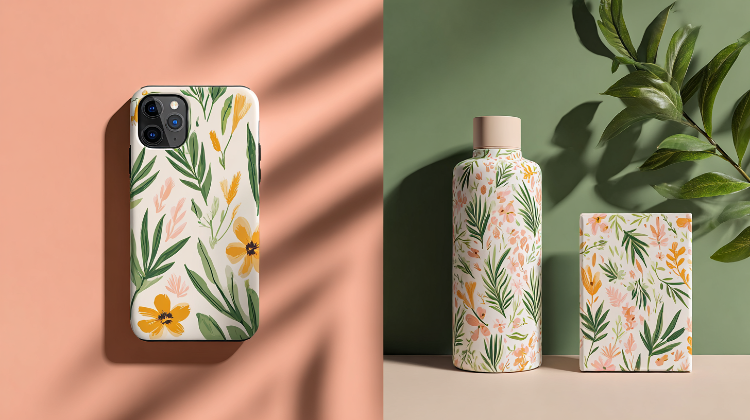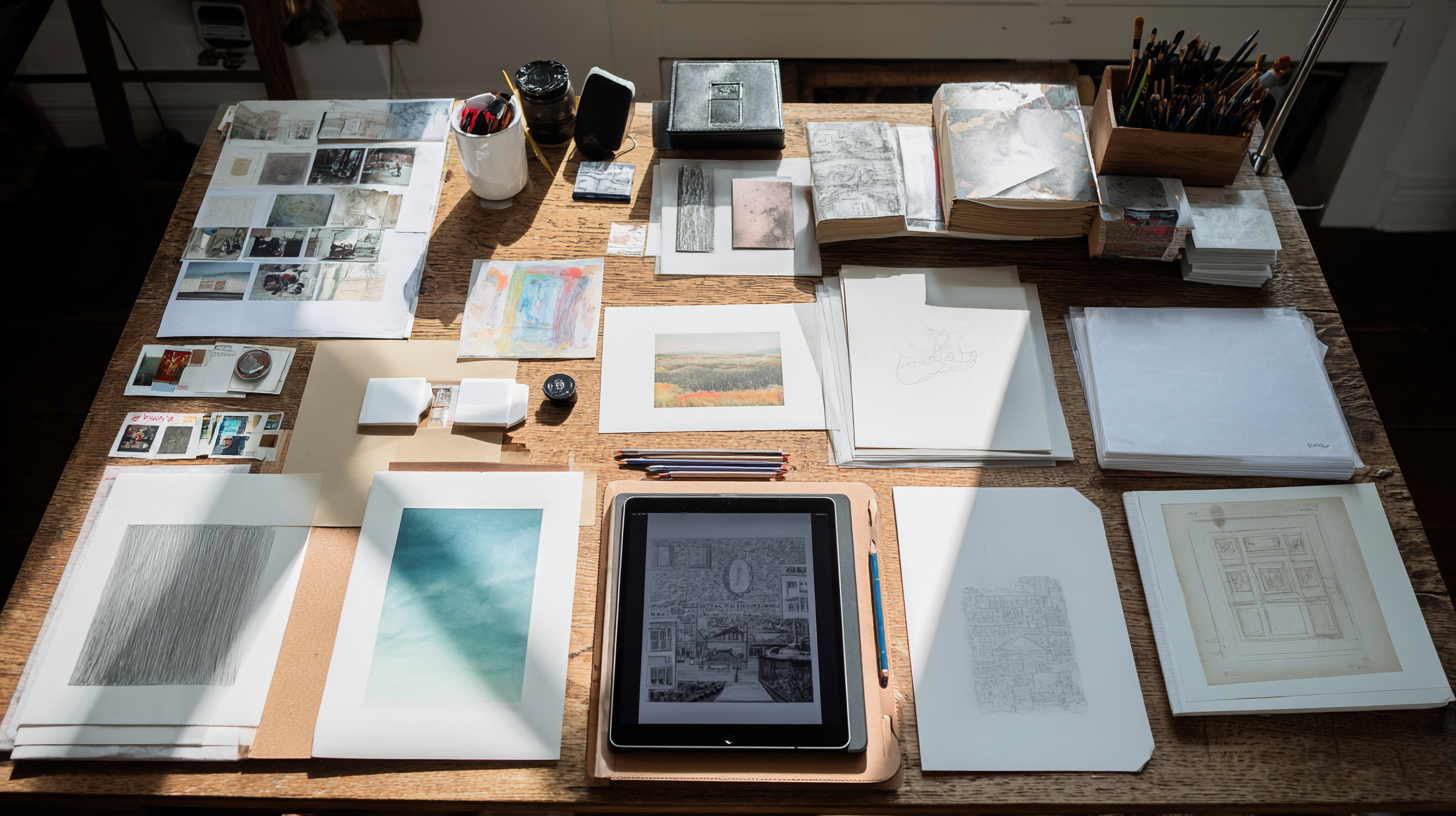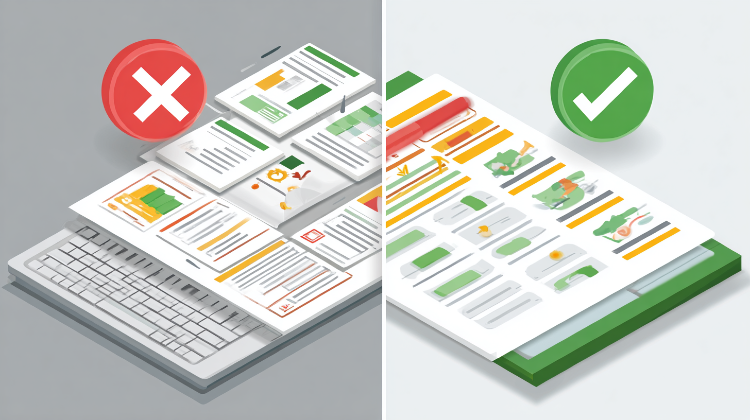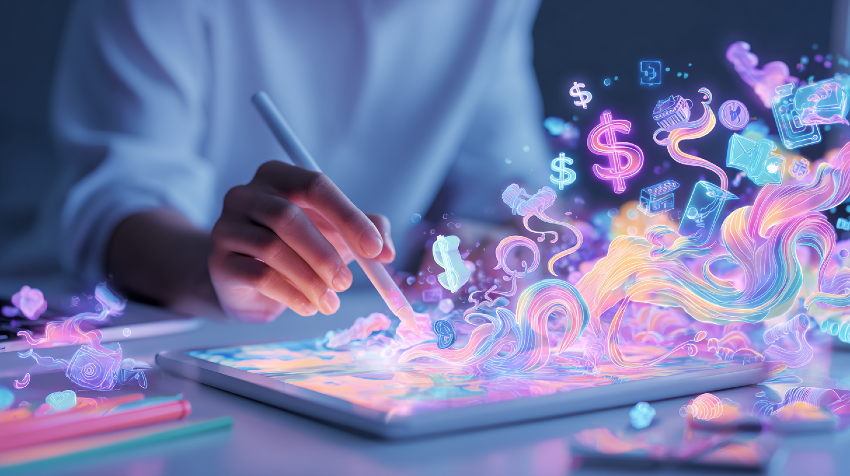Have you ever wondered how your digital artwork could keep earning money while you sleep? You're not alone—and you're in the right place to find out. The digital art market is absolutely booming, with industry experts projecting it will grow from $5.8 billion in 2025 to $17.72 billion by 2032. Yet here's the thing: most talented digital artists are still stuck in the feast-or-famine cycle, selling their work once and moving on to the next piece.

Here's where digital art licensing for beginners becomes a game-changer. Instead of selling your artwork outright, licensing allows you to "rent" your creations to companies who use them on products like phone cases, home décor, clothing, and stationery—all while you retain ownership and earn ongoing royalties. Think of it as turning your art into a passive income machine that works around the clock.
The global licensing industry has reached a staggering $369.6 billion, and there's never been a better time for artists to grab their slice of this pie. With 55% of galleries increasing digital content and online art sales surpassing $12 billion globally in 2025, the opportunities are endless.
In this comprehensive guide, you'll discover exactly how to transform your digital artwork into multiple streams of passive income through licensing, no matter your experience level. Ready to turn your creativity into a sustainable business? Let's dive in.
What is Digital Art Licensing?
Digital art licensing is essentially "renting" your artwork to companies for use on their products while you retain full copyright ownership. Unlike selling your art outright, licensing allows you to grant specific usage rights to businesses, creating a recurring revenue stream from the same piece of artwork.

Definition and Core Concept
Think of digital art licensing as becoming a landlord for your creative property. Companies like Target, Anthropologie, and Urban Outfitters pay you for permission to use your designs on products ranging from phone cases and home décor to clothing and stationery. You maintain ownership while they gain the right to reproduce your work within agreed-upon parameters.
The key distinction from traditional art sales is ongoing earning potential. One design can generate income across multiple products, companies, and time periods. This model has enabled artists like Cat Coquillette to see her watercolor designs in major retail stores while building a sustainable creative business.
How Digital Art Licensing Works
The process follows a straightforward workflow: Artist creates → Company pays for rights → Products manufactured → Artist receives royalties. Companies actively seek fresh designs to differentiate their products in competitive markets. Licensed artwork typically appears on everything from greeting cards and gift wrap to bedding and wall art.
Licensing agreements can be exclusive (higher rates, single licensee) or non-exclusive (multiple licensees, broader market reach). Artists typically earn 5-15% royalties on wholesale prices, with some deals including upfront payments or flat fees.
Why Digital Art Licensing Matters in 2025
The digital art market is experiencing unprecedented growth, projected to expand from $7.24 billion in 2025 to $30.69 billion by 2035 at a 15.53% CAGR. This boom is driven by expanding e-commerce platforms, growing print-on-demand services, and increasing demand for unique visual content across industries.
The copyright licensing market is projected to reach $289.30 billion by 2032, with digital platforms creating new opportunities for artists to monetize their work globally. For artists seeking sustainable careers, licensing offers the perfect balance of creative freedom and financial stability through passive income generation.
Types of Digital Art Licensing Agreements
Understanding the different types of digital art licensing agreements is crucial for maximizing your revenue potential and protecting your creative work. Each licensing structure offers distinct advantages and considerations that can significantly impact your long-term earning potential as a digital artist.

Exclusive vs. Non-Exclusive Licenses
Exclusive licensing agreements grant the licensee sole rights to use your artwork within specified parameters, meaning you cannot license the same piece to another party during the contract period. This exclusivity typically commands premium pricing, often 25-50% higher than non-exclusive rates. For example, if a home décor company secures exclusive rights to your botanical illustration for throw pillows, no other manufacturer can use that design for similar products during the agreement term.
Non-exclusive licensing agreements allow you to license the same artwork to multiple companies simultaneously, creating diverse revenue streams from a single piece. While individual rates are lower—typically 3-8% royalties compared to 8-15% for exclusive deals—the cumulative income potential can be substantial when licensing across different product categories and territories.
License Categories by Usage Rights
Personal use licenses restrict artwork usage to non-commercial purposes, such as personal projects, gifts, or individual social media posts. These licenses typically generate lower fees but broader market appeal, making your work accessible to hobbyists and casual users. The key restriction is that usage cannot result in direct or indirect monetary gain.
Commercial use licenses allow businesses to use your artwork for profit-generating activities, including product manufacturing, advertising, and retail sales. These licenses command significantly higher rates—often 5-10 times personal use pricing—because they enable licensees to monetize your creative work. Commercial licenses typically include specific usage parameters such as product categories, distribution channels, and promotional rights.
Editorial licenses permit usage in news articles, documentaries, educational materials, and journalistic content. These licenses can include recognizable people and logos without additional releases, but restrict commercial applications. Editorial usage focuses on informational rather than promotional purposes.
Common License Terms and Scope
Territory clauses define geographical boundaries where your artwork can be used, from local markets to worldwide distribution. Exclusive worldwide licenses can command premium rates of 15-25% royalties, while regional exclusivity typically ranges from 8-15%. Duration terms specify contract length, with perpetual licenses requiring higher upfront investment but offering long-term revenue stability.
Media restrictions clarify approved usage formats, whether digital display, print applications, or product manufacturing. These specifications protect your work from unauthorized adaptations while ensuring appropriate compensation for intended use cases.
Royalty vs. Flat Fee Structures
Royalty-based agreements provide ongoing income through percentage-based payments on wholesale prices, typically ranging from 5-15% depending on exclusivity and product category. This structure aligns your success with the licensee's sales performance and can generate substantial passive income over time.
Flat fee structures offer predictable upfront payments without ongoing royalty obligations. While eliminating future earning potential, flat fees provide immediate cash flow and simplified accounting. Industry standards suggest flat fees should equal 12-18 months of projected royalty income to compensate for lost future revenue.
Hybrid models combine upfront advances against future royalties, providing immediate payment while maintaining long-term earning potential. Guaranteed minimum royalty payments ensure baseline income regardless of sales performance, with typical minimums ranging from $2,000-$15,000 annually, depending on exclusivity and market scope.
Getting Started with Digital Art Licensing
Breaking into digital art licensing for beginners doesn't have to be overwhelming. With the right preparation and strategic approach, you can transform your creative passion into a sustainable income stream. Here's your step-by-step roadmap to launching your art licensing journey successfully.

Essential Prerequisites
Before pursuing licensing opportunities, establish the fundamental building blocks of your business. Copyright protection is automatic upon creation, but consider formal registration with the U.S. Copyright Office for enhanced legal protection. This investment typically costs $35-85 and provides stronger enforcement rights should disputes arise.
Build a cohesive portfolio of 15-20 high-quality pieces that showcase your unique artistic voice. Quality trumps quantity—licensees prefer artists with consistent style and professional presentation over those with scattered aesthetics. Focus on creating artwork that tells a story and evokes specific emotions, as this resonates strongly with licensing partners.
Research market demand by studying current trends and successful licensing artists. Popular categories in 2025 include biophilic designs, maximalist florals, sustainable themes, and nostalgic patterns. Follow industry leaders on social media and analyze what's trending on platforms like Society6 and Shutterstock to identify market opportunities.
Creating License-Ready Artwork
Technical specifications are crucial for licensing success. Work at 300 DPI minimum and create artwork large enough for various applications—industry professionals recommend starting with 12×16 inches or larger. For digital artists using Procreate, optimal canvas sizes include 16×20 inches at 300 DPI in RGB color mode.
File format requirements vary by client, but most licensing companies prefer high-resolution JPEG or TIFF files. Always save your work in the highest quality possible—you can scale down, but never effectively scale up without quality loss. Consider creating both RGB (for digital use) and CMYK (for print) versions of your artwork.
Maintain detailed documentation of your creative process, including inspiration sources, color palettes, and technical specifications. This professional approach demonstrates credibility and helps streamline the licensing process.
Building Your Digital Art Portfolio
Organize your portfolio thematically to make navigation effortless for potential licensees. Group related pieces together and ensure your strongest work is prominently featured. A well-organized portfolio demonstrates professionalism and makes it easier for art directors to envision your work on their products.
Focus on versatility within consistency—show range in your established style without confusing your artistic identity. Your portfolio should serve as a "menu" of available designs, as licensing buyers often purchase directly from existing work rather than commissioning new pieces.
Invest in professional presentation through high-quality portfolio images and compelling descriptions. Include context about intended applications and target markets to help licensees understand your work's commercial potential.
Pricing Your Digital Art Licenses
Setting the right price for your digital art licenses is crucial for building a sustainable creative business. Understanding industry standards and key pricing factors will help you negotiate fair deals that reflect your work's true value in the marketplace.

Factors Affecting Pricing
Client size and budget significantly impact your licensing rates. Large corporations like Target or Urban Outfitters typically have bigger budgets and can afford higher licensing fees, while small startups may require more modest pricing structures. Usage scope also plays a critical role—licensing artwork for limited regional use costs less than worldwide distribution rights.
Exclusivity demands premium pricing. Exclusive licensing agreements typically command 25-50% higher rates than non-exclusive deals because you're restricting your ability to license the same artwork to other companies. Territory coverage is equally important—exclusive worldwide licenses can justify 15-25% royalty rates, while regional exclusivity typically ranges from 8-15%.
Royalty Rate Guidelines
Industry standards for digital art licensing royalties typically fall between 3-15% of wholesale prices. For most licensing agreements, you'll likely earn 5-10% royalties, though rates can vary based on product categories. Art lithographs average 5-15%, while simpler products like wristbands typically see 3-6.5% royalty rates.
Flat fee structures offer predictable upfront payments without ongoing royalty obligations. Industry experts suggest flat fees should equal 12-18 months of projected royalty income to compensate for lost future earnings. This approach provides immediate cash flow but eliminates long-term earning potential.
Negotiation Strategies
Research your client's budget before presenting rates—many companies have established licensing budgets for their product lines. Never accept the first offer without negotiation, as there's typically room for improvement in initial proposals.
Consider minimum guarantees to ensure baseline income regardless of sales performance. Typical minimums range from $2,000-$15,000 annually, depending on exclusivity and market scope. Bundle additional benefits like logo placement, social media promotion, or portfolio testimonials to increase overall deal value beyond monetary compensation.
Transparency and professional communication build trust during negotiations. Present your pricing rationale clearly, emphasizing the long-term value your artwork brings to their product line and brand identity.
Legal Considerations and Copyright Basics
Understanding the legal framework surrounding digital art licensing is crucial for protecting your creative work and building a successful licensing business. Whether you're a beginner artist or an experienced creator, these foundational legal concepts will safeguard your intellectual property rights and licensing opportunities.

Copyright Fundamentals for Digital Artists
Copyright protection exists automatically the moment you create and fix your digital artwork in a tangible medium. Your digital art receives immediate copyright protection without requiring formal registration, paperwork, or fees. This fundamental principle under U.S. copyright law means your work is protected from the instant you save that digital file.
However, copyright registration provides significant advantages for licensing artists. Registration enables you to file infringement lawsuits in federal court, claim statutory damages up to $150,000 per infringement, and recover attorney's fees. For digital artists entering licensing, registration costs only $35-85 but provides enhanced legal protection that can be worth thousands in enforcement actions.
Recent 2025 developments have clarified that AI-generated artwork requires meaningful human creative input to qualify for copyright protection. The U.S. Copyright Office and federal courts have ruled that works created entirely by AI without human contribution cannot be copyrighted. This reinforces the value of human creativity in digital art licensing.
Creative Commons and Alternative Licenses
Creative Commons (CC) licenses offer strategic alternatives to traditional "all rights reserved" copyright, allowing controlled sharing while maintaining ownership. The six main CC license types range from most to least permissive, with CC BY-NC licenses being particularly useful for artists wanting to build an audience while preserving commercial licensing rights.
Consider using Creative Commons licenses strategically to build brand awareness or establish artistic reputation while maintaining full copyright control over your most marketable pieces.
Fair Use and Your Rights
Fair use provisions allow limited use of copyrighted material without permission under specific circumstances, evaluated through four factors: purpose and character of use, nature of the work, amount used, and market effect. For digital artists, fair use typically applies to educational uses, criticism, commentary, and transformative works.
Protecting your work requires proactive measures. Use digital watermarking to deter unauthorized use, monitor for infringement through reverse image searches, and maintain detailed documentation of your creative process. When infringement occurs, start with informal contact, then escalate to DMCA takedown notices and cease-and-desist letters before considering legal action.
Understanding these legal fundamentals provides the foundation for successful digital art licensing while protecting your creative assets and building sustainable licensing relationships.
Top Platforms and Marketplaces for Digital Art Licensing
Choosing the right platform for your digital art licensing journey can significantly impact your success and revenue potential. Understanding the landscape of available options will help you make strategic decisions about where to invest your time and creative energy.
Major Licensing Platforms
Shutterstock remains the industry leader for digital art licensing, offering broad market reach and established client relationships. Artists typically earn 5-15% royalties on standard licenses, though competition is fierce with over 600,000 contributors. The platform provides strong legal protection and indemnification coverage up to $10,000 for standard licenses.
Adobe Stock integrates seamlessly with Creative Cloud applications, making it attractive to professional designers and agencies. The platform offers standard licenses starting at $0.26-$9.99 and enhanced licenses with higher royalty potential. Adobe Stock's editorial licensing options provide opportunities for newsworthy and documentary-style artwork.
Getty Images targets the premium market with higher quality standards and correspondingly better compensation. While more selective in their acceptance process, successful artists can command premium rates for exclusive licensing arrangements. Getty Images offers comprehensive rights and clearance services for complex licensing needs.
Print-on-Demand Platforms
Society6 specializes in lifestyle products and home décor, offering artists a 10% commission rate on most products, with artist-controlled pricing on art prints. The platform has recently implemented shipping fee deductions ranging from $0.30-$8.00 per sale, but remains popular for its premium product quality and strong brand recognition.
Redbubble provides complete pricing control for artists, allowing for potentially higher profit margins through strategic markup strategies. The platform introduced a tiered account system in 2025, with fee structures varying by tier level. Redbubble excels in apparel and accessories categories with a global marketplace reach.
Printful and Printify offer integration with existing e-commerce stores, enabling artists to maintain brand control while accessing print-on-demand services. These platforms typically provide higher profit margins since artists control their own pricing and marketing strategies.
Direct Licensing Opportunities
Cold outreach to companies remains highly effective for experienced artists. Research target companies' product lines and art directors, then present a curated portfolio that aligns with their brand aesthetic. Success stories include artists landing deals with Target, Anthropologie, and Urban Outfitters through strategic outreach.
Trade shows like Surtex and Licensing Expo provide face-to-face networking opportunities with art directors and licensing professionals. Art licensing agents can be valuable partners once you've established a proven track record, typically taking 25-50% commission but providing industry connections and negotiation expertise.
The key to success across any platform is consistent quality, strategic pricing, and persistent marketing efforts. Most successful licensing artists diversify across multiple platforms to maximize their revenue streams and market exposure.
Common Mistakes to Avoid
Even experienced digital artists can stumble when entering the digital art licensing market. Understanding these common pitfalls will help you navigate the industry more effectively and build a professional reputation that attracts quality licensing opportunities.

Portfolio and Presentation Mistakes
Inconsistent quality is perhaps the most damaging mistake for aspiring licensing artists. Mixing amateur work with professional pieces creates confusion for potential clients and undermines your credibility. Art directors typically spend only 30-60 seconds reviewing portfolios, so every piece must represent your best work.
Poor file organization signals unprofessionalism to licensing partners. Ensure your portfolio includes properly named files, consistent formatting, and easy navigation. Industry professionals report that 67% of licensing opportunities are lost due to poor presentation and organization rather than artistic quality.
A weak online presence severely limits your licensing potential. In 2025, 89% of art directors research artists online before making contact. Invest in a professional website that showcases your work effectively and includes clear contact information and licensing availability.
Legal and Business Mistakes
Signing contracts without a thorough review is a costly error that can impact your career for years. Always read licensing agreements carefully, paying attention to territory restrictions, exclusivity clauses, and usage rights. When in doubt, consult with an intellectual property attorney—their fees are minimal compared to potential losses from unfavorable contracts.
Underpricing your work devalues not only your own art but the entire licensing industry. Research industry standards and factor in your time, expertise, and the commercial value you provide. Remember that quality licensing deals typically range from 5-15% royalties on wholesale prices.
Giving up too many rights unnecessarily restricts your future earning potential. Maintain control over your intellectual property by carefully reviewing what rights you're granting and for how long.
Strategic Mistakes
Lack of market research leads to creating artwork that doesn't align with commercial needs. Study current trends, successful licensing artists, and target market preferences before developing new work. Impatience in this relationship-based industry can sabotage long-term success—building licensing relationships typically takes 6-12 months of consistent effort.
Building Your Digital Art Licensing Business
Creating a sustainable digital art licensing business requires strategic planning that balances immediate opportunities with long-term growth. Success in this industry isn't just about creating beautiful artwork—it's about building a professional brand that attracts and retains licensing partners over time.

Creating a Sustainable Strategy
Diversify your income streams across multiple platforms and client relationships to reduce risk and maximize earning potential. Industry leaders recommend working with 3-5 different licensing partners simultaneously rather than relying on a single source. This approach provides stability when one partnership ends or sales fluctuate seasonally.
Build long-term relationships with art directors and licensing companies by consistently delivering high-quality work and maintaining professional communication. Many successful artists report that 80% of their licensing deals come from repeat clients who trust their reliability and artistic vision.
Marketing and Promotion Tactics
Leverage social media strategically to showcase your work and attract licensing opportunities. Instagram, Pinterest, and TikTok are particularly effective for visual artists, with studies showing that consistent posting increases licensing inquiries by 45%. Share behind-the-scenes content, process videos, and finished artwork to build an engaged following.
Email marketing remains crucial for maintaining direct contact with potential licensees, providing an average $42 return for every $1 spent. Create targeted campaigns featuring new artwork releases and availability updates to stay top-of-mind with art directors.
Continuous professional development through online courses, industry workshops, and networking events ensures your skills and market knowledge remain current in this rapidly evolving field.
Tools and Resources for Success
Building a thriving digital art-licensing business is easier when you leverage the right mix of creative, legal, and administrative tools. Below is a curated toolkit designed for beginners and seasoned artists alike.
Create & Prepare Artwork:
- Adobe Creative Cloud, Procreate, Clip Studio Paint
- Industry-standard software ensures your files meet 300 DPI, RGB/CMYK, and layered-format demands for licensing partners.
Copyright Protection & Licensing:
- Wacom Yuify for blockchain-backed micro-marks, Creative Commons license selector, Arts Law contract templates
- These services embed ownership data, let you tailor licenses, and provide lawyer-vetted agreements, reducing infringement risk and negotiation time.
Portfolio Hosting:
- ArtStation (pro market), Behance (broad visibility), Art Licensing Show (private B2B sharing)
- Professional, searchable portfolios attract art directors and can be password-protected for exclusive pitches.
Royalty & Contract Management:
- Artonomo all-in-one dashboard, Royalty Tracker®, or Tipalti for automated statements and global payouts
- Automates complex royalty splits, minimum guarantees, and multi-currency payments so you can focus on creating.
Market Research & Community:
- DeviantArt, ArtStation job board, TapeReal behind-the-scenes content, online art communities round-ups
- Tracking trends and networking with peers helps you align designs with demand and discover new clients.
Pro tip: integrate at least one copyright-tracking tool with a royalty platform; this "protection-to-payment pipeline" lets you monitor usage and revenue in a single workflow, accelerating your path from concept to passive income.
Conclusion
Digital art licensing for beginners represents one of the most accessible paths to building sustainable passive income from your creative work. Throughout this guide, we've explored how licensing allows you to retain ownership while earning ongoing royalties from companies that use your designs on their products, transforming a single artwork into multiple revenue streams.
The key to success lies in proper preparation and professional execution. From building a cohesive portfolio of 15-20 high-quality pieces to understanding contract negotiations and royalty structures, every element contributes to your long-term success. Remember that licensing is a relationship-based industry where consistency, quality, and professionalism open doors to lucrative opportunities.
Your next steps are clear: Start by creating license-ready artwork at 300 DPI, researching platforms like Shutterstock and Society6, and begin building relationships with art directors in your target markets. Focus on developing a recognizable style while staying current with market trends like nature-inspired designs and nostalgic aesthetics that are driving demand in 2025.
The $369.6 billion global licensing industry has room for your unique creative voice. With the digital art market projected to reach $30.69 billion by 2035, representing a remarkable 15.53% CAGR, there's never been a better time to transform your artistic passion into a thriving business. The art market is experiencing a fundamental transformation with increased digital adoption and online sales growth, creating unprecedented opportunities for digital artists.
Your journey to passive income through art licensing starts today—take that first step and watch your creativity pay dividends for years to come.


